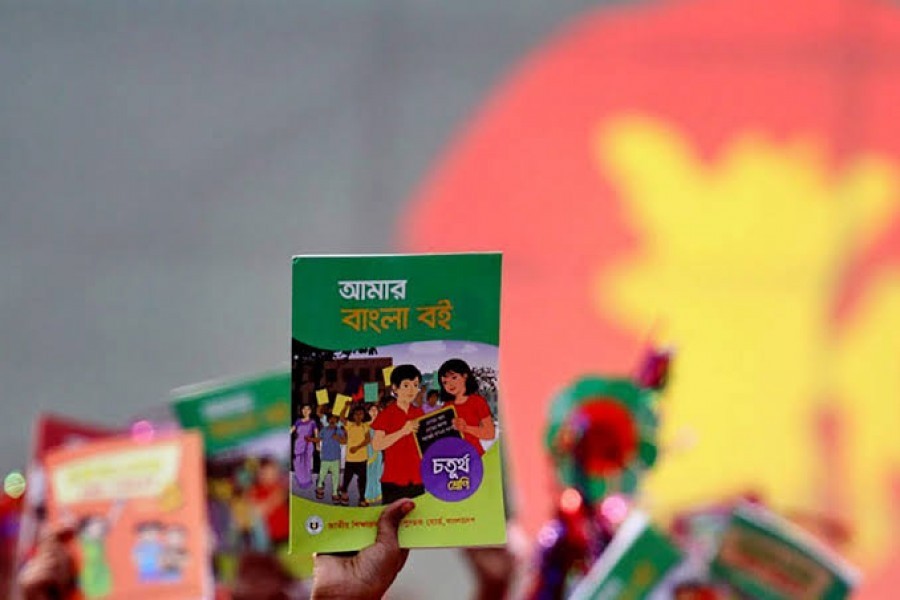After days of an overcast sky and cold weather, the day of January 1 was amazingly different. It was sunny and the bright day appeared to have reflected the mood of school children across the country.
Like in the previous years, cheerful children were seen collecting their free textbooks from teachers. Some clutched their books to their bosom as they ran towards their homes; while many began leafing through the books, the sweet-pungent smell of the brand new books overwhelming them. The spectacles around the school compounds in the whole county were marked by a unique vibrancy.
Launched in 2010, the distribution of free textbooks has been taking place for the last 10 years. This year, Prime Minister Sheikh Hasina formally inaugurated the programme of distribution of textbooks among the primary and secondary-level school students at Ganabhaban on December 31, 2019. On January 1, 2020, distribution of primary-level books was held at the Dhaka University Ground. State Minister for Primary and Mass Education Md. Zakir Hossain distributed books among the primary-level students. Earlier on the day Education Minister Dr. Dipu Moni launched the distribution of textbooks for secondary-level students at the compound of Adhar Chandra Government High School in Savar.
Apart from the distribution of books written in Bangla, five indigenous community students received books up to Class-III written in their languages. Apart from the two main venues, an ambience of spontaneous festivity prevailed in the schools all over the country.
The school textbooks distributed annually for free had sparked uproar over quality of printing and paper in some years. Controversies raged on some other issues, too. The most prominent among them were changes made to the subjects of the Bangla textbooks. The issue had drawn a great amount of resentment and disapproval from academics and the intelligentsia.
In the meantime, the innocent students remained confused and surprised as they found pieces written by renowned authors dropped from writers' list. The textbook authorities came up with assurances that the new writers' list would be subject to scrutiny and revision. To the dismay of school curriculum experts, initiatives to rationalise the content of the authors and their pieces have yet to materialise.
Textbooks are the first stepping-stone for students into greater spheres of learning and enlightenment. Both educationists and experts dealing with student psychology lay special stress on the textbook subjects' unbroken consistency. Any abrupt disruption in the curricular norm carries potential for students' failure to grow the required love for some vital lessons.
It's time the policymakers and authorities dealing with primary and secondary-level education realised the criticality of the issue. The sooner, the better it is. For, the massive programme the government has undertaken can in no way be frittered away senselessly. It's because, the country's fast rise in the rate of education can indisputably be credited with the government's stress on the education sector.
Grappling with a literacy rate stuck at around 30 per cent in the erstwhile East Pakistan, Bangladesh now takes pride in its literacy on the verge of nearing 75 per cent. This is no mean achievement. The unabated educational achievements of secondary-level students have been contributing significantly to the rise in country's literacy. Free textbooks serve as a great fillip for them in achieving better JSC, and later SSC, results and continuing their studies in higher classes.
There are, however, discouraging pictures at the primary level. Although equipped with all the necessary textbooks, high dropout rates at the primary level still exist as a damper. One of the main reasons which have dogged these lower-grade learners is a development of apathy for studies. Apart from the poverty-stricken parents' unwillingness to send their children to school and engaging them in agricultural or household works, there are some other disincentives. Academics single out the lack of properly educated and trained teachers for this virtually perennial drawback. Most of the students at the primary level perform poorly in English and math. The tiny tots and the older children take in the lessons ineptly imparted to them by their teachers. Unless arrangements are made to prepare the primary-level students with English and math proficiency, the cost for publishing their free textbooks might one day emerge as sheer wastage.
In reality, the project of distributing free textbooks is aimed at taking students to the final grade of the secondary level. Students dropping out of their studies half way through will only thwart the noble objective of building a truly literate nation.
Publishing and printing free school textbooks involves a huge expenditure. The government has, in fact, undertaken the massive project that carries 'socialistic' undertones. In the age of market economy, private entrepreneurship and less involvement of government in the vital sectors, distribution of free books among students points to a bold policy. It's one that goes against the economic trends now prevailing globally. Few countries have programmes in place for distributing textbooks for students for free at primary and secondary levels. In this respect, Bangladesh emerges as a great exception.
The project has paid dividends as has been seen in the better results of school students in the public examinations. But a mismatch between the expenditures on free books and the performance of students continues to trouble the programme. Mere distribution of free textbooks in a festive atmosphere cannot fully prepare school students for fruitful studies in their classes. Unless the drawbacks related to imparting of lessons are addressed efficiently, the whole venture may prove an exercise in futility. Everyone ought to keep in mind that the publication and distribution of the books has involved a huge amount of money. A total of about 353.14 million textbooks were distributed among 4,26,19,865 primary and secondary-level students for the 2020 academic year.


